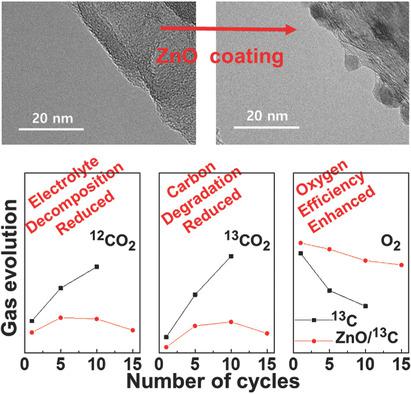当前位置:
X-MOL 学术
›
Adv. Energy Mater.
›
论文详情
Our official English website, www.x-mol.net, welcomes your feedback! (Note: you will need to create a separate account there.)
Enhanced Stability of Coated Carbon Electrode for Li‐O2 Batteries and Its Limitations
Advanced Energy Materials ( IF 27.8 ) Pub Date : 2018-02-14 , DOI: 10.1002/aenm.201702661 Youngjoon Bae 1 , Dong-Hyun Ko 2 , Sunyoung Lee 2 , Hee-Dae Lim 1 , Yun-Jung Kim 3 , Hyun-Soo Shim 1 , Hyeokjun Park 1 , Youngmin Ko 1 , Sung Kwan Park 1 , Hyuk Jae Kwon 4 , Hyunjin Kim 4 , Hee-Tak Kim 3 , Yo-Sep Min 2 , Dongmin Im 4 , Kisuk Kang 1
Advanced Energy Materials ( IF 27.8 ) Pub Date : 2018-02-14 , DOI: 10.1002/aenm.201702661 Youngjoon Bae 1 , Dong-Hyun Ko 2 , Sunyoung Lee 2 , Hee-Dae Lim 1 , Yun-Jung Kim 3 , Hyun-Soo Shim 1 , Hyeokjun Park 1 , Youngmin Ko 1 , Sung Kwan Park 1 , Hyuk Jae Kwon 4 , Hyunjin Kim 4 , Hee-Tak Kim 3 , Yo-Sep Min 2 , Dongmin Im 4 , Kisuk Kang 1
Affiliation

|
Li‐O2 batteries are promising next‐generation energy storage systems because of their exceptionally high energy density (≈3500 W h kg−1). However, to achieve stable operation, grand challenges remain to be resolved, such as preventing electrolyte decomposition and degradation of carbon, a commonly used air electrode in Li‐O2 batteries. In this work, using in situ differential electrochemical mass spectrometry, it is demonstrated that the application of a ZnO coating on the carbon electrode can effectively suppress side reactions occurring in the Li‐O2 battery. By probing the CO2 evolution during charging of 13C‐labeled air electrodes, the major sources of parasitic reactions are precisely identified, which further reveals that the ZnO coating retards the degradation of both the carbon electrode and electrolyte. The successful suppression of the degradation results in a higher oxygen efficiency, leading to enhanced stability for more than 100 cycles. Nevertheless, the degradation of the carbon electrode is not completely prevented by the coating, because the Li2O2 discharge product gradually grows at the interface between the ZnO and carbon, which eventually results in detachment of the ZnO particles from the electrode and subsequent deterioration of the performance. This finding implies that surface protection of the carbon electrode is a viable option to enhance the stability of Li‐O2 batteries; however, fundamental studies on the growth mechanism of the discharge product on the carbon surface are required along with more effective coating strategies.
中文翻译:

Li-O2电池涂层碳电极的增强稳定性及其局限性
Li-O 2电池具有极高的能量密度(≈3500 W h kg -1),因此有望成为下一代储能系统。但是,要实现稳定的运行,仍需解决巨大的挑战,例如如何防止电解质分解和碳降解,碳是Li-O 2电池中常用的空气电极。在这项工作中,使用原位差分电化学质谱法表明,在碳电极上应用ZnO涂层可以有效抑制Li-O 2电池中发生的副反应。通过探测13充电过程中的CO 2释放用C标记的空气电极可精确识别出寄生反应的主要来源,这进一步表明ZnO涂层可阻止碳电极和电解质的降解。成功抑制降解可提高氧气效率,从而在超过100个循环中提高稳定性。然而,涂层不能完全防止碳电极的降解,因为Li 2 O 2放电产物在ZnO和碳之间的界面上逐渐生长,最终导致ZnO颗粒从电极上脱落并随后变质。的表现。这一发现表明,碳电极的表面保护是增强Li-O稳定性的可行选择。2个电池;但是,需要对放电产物在碳表面上的生长机理进行基础研究,以及更有效的涂层策略。
更新日期:2018-02-14
中文翻译:

Li-O2电池涂层碳电极的增强稳定性及其局限性
Li-O 2电池具有极高的能量密度(≈3500 W h kg -1),因此有望成为下一代储能系统。但是,要实现稳定的运行,仍需解决巨大的挑战,例如如何防止电解质分解和碳降解,碳是Li-O 2电池中常用的空气电极。在这项工作中,使用原位差分电化学质谱法表明,在碳电极上应用ZnO涂层可以有效抑制Li-O 2电池中发生的副反应。通过探测13充电过程中的CO 2释放用C标记的空气电极可精确识别出寄生反应的主要来源,这进一步表明ZnO涂层可阻止碳电极和电解质的降解。成功抑制降解可提高氧气效率,从而在超过100个循环中提高稳定性。然而,涂层不能完全防止碳电极的降解,因为Li 2 O 2放电产物在ZnO和碳之间的界面上逐渐生长,最终导致ZnO颗粒从电极上脱落并随后变质。的表现。这一发现表明,碳电极的表面保护是增强Li-O稳定性的可行选择。2个电池;但是,需要对放电产物在碳表面上的生长机理进行基础研究,以及更有效的涂层策略。



























 京公网安备 11010802027423号
京公网安备 11010802027423号